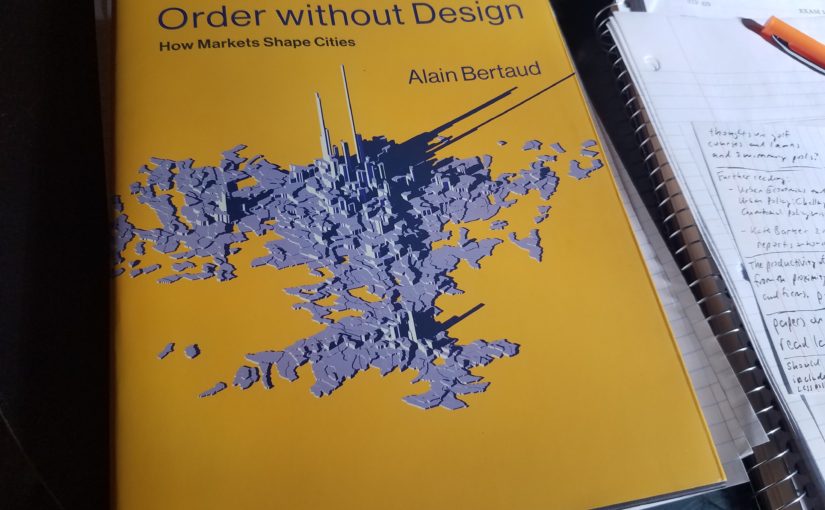Highly recommend the book, “Order without Design: How Markets Shape Cities” by Alain Bertaud.
Especially recommended for professional urban planners, armchair urban planners, people looking to better understand how their cities work, and nerds looking for healthy doses of graphs, statistics, and analysis to inform their municipal commentary and priorities.
For me, this book fed my confirmation bias that it’s all about mobility, and also challenged and changed my views on sprawl and density constraints. It also introduced me to some next-level ways of thinking about housing affordability and cities as labor markets.
Here are some of my notes, comments and favorite excerpts. I put direct excerpts in quotations, and delineate my personal commentary using AF Comment. Everything else is pretty much me picking out takeaways, summarizing and paraphrasing to varying degrees.
For more on these topics, be sure to listen to interviews with author Alain Bertaud on Conversations with Tyler (Tyler Cowen) and EconTalk (Russ Roberts).
Exposing distinctions
Growth via Giving vs Growth via Taking: There’s a big difference between cities that are growing by producing (giving) and cities that are growing by consuming. Both may have growing populations; however, the former features growing labor markets and mobility, while the latter features growing consumer markets and dependency ratios.
AF Comment: I venture to guess that Phoenix falls into the latter category, with strong (and misleading) population growth that’s dominated by people who are not contributing to the labor market (e.g. retirees, students, tourists). For cities like Phoenix, we should look to Japan as an example of the path and challenges ahead: aging population, low fertility, and a struggle to retain young citizens.
Housing Policy vs Social Welfare: It is important from the beginning to separate emergency social welfare from housing policy. Housing affordability metrics need to be conditioned and assessed across household income groups.
Climate Change vs Air Pollution: Solving the pollution problem and cleaning up the air in a city is different than tackling climate change.
AF Comment: We can save thousands of lives locally by cleaning the air locally, no matter what your stance is on the political rallying cry that has become Climate Change.
Less is more: urban planning via negativa
“Do We Really Want Our Mayors and Planners to Have a Vision?”
Instead, their major role to play is to improve mobility and ensure housing affordability.
AF Comment: We know the answers. We know what we need to do and we’ve known all along. We just need to dig up the solutions from under the rubble and bring them back to life. These solutions are the boring, unsexy, painful, politically unpopular, won’t get you re-elected, effective, adaptive solutions – like pricing signals – right under our noses.
“A city has to be submitted to a Darwinian evolutionary process, negating the very concept of design with a known finality.”
AF Comment: Let cities be messy, strip down arbitrary regulations to the core essentials and let the beauty of the market and randomness and human creativity take it from there. Similar to a plan for life: build a few core principles and let the rest just happen, guts and heart.
“The population density in a particular neighborhood is determined by trade-offs between households’ desire to consume more land and floor space and the commuting cost in time and money.”
AF Comment: I need to change the way I think about “sprawl.” Sprawl is not necessarily lack of density. There is no optimum density for urban development, and it’s not up to the planners to decide what the right density should be, or how populations should be distributed. Instead:
“They can design transport systems that decrease commuting time and cost, another way of increasing the supply of land increasing mobility.”
Mobility
“Urban transport is a real estate problem. A municipality is the owner of the streets. The rent charged for using the street should be based on how large an area, how long, when, and where a commuter is using it.”
“Increasing mobility (i.e. decreasing the time required to go from one part of a metropolitan area to another) … requires a concerted action on the demand side. The demand side includes calculating how much street space each commuter consumes and what measures could be taken to decrease not demand for trips but demand for street space.”
The big challenge and key indicator for cities: integrating labor markets and finding ways to link people to jobs within a 1-hour commute.
Metrics and output indicators need to be measured (with budget allocations following suit) at capacity; find the most effective way to transport an increased and targeted number of workers from where they live to where they work at peak hour.
“The fact that a bus line is well used does not necessarily mean that the objective has been met.”
“Calls to Action for the Future of Mobility” (I’m summarizing and paraphrasing these).
- Allow multimode transport systems to reflect consumer demand
- New transport systems should adapt to evolving spatial structures
- Pollution and GHG emission targets
- Congestion pricing of road space
- Individual commuter cars will have to be redesigned to reduce their road footprint and weight
- Shared self-driving cars
If I only remember one thing from this book: less is more
Let cities be messy. Let the market do its thing. Make clear distinctions between public and private property, and then let human creativity fill the space and grow into something that you never could have imagined.
